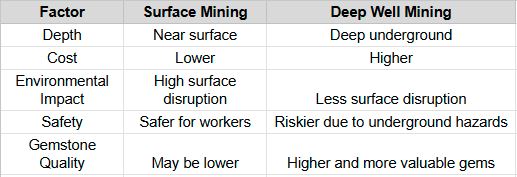Gemstones have captivated humans for centuries with their beauty and rarity. Placed in exquisite jewelry or utilized as precious stones on a collection, these earth-formed gems are imagined far below the earth. But how are gemstones actually mined? There are two main methods: surface mining and deep well mining. Each has its own process, benefits, and environmental effect. In this blog, we will see both processes so that you understand how these lovely stones are taken from the earth to your jewelry box.
What Are Gemstones?
Gemstones are naturally occurring minerals that are cut and polished into ornaments mainly for jewelry. Diamonds, rubies, sapphires, and emeralds are some of the most popular gemstones. Their rarity, hardness, and brilliance make them very valuable in many industries.
Overview of Gemstone Mining
Mining is digging gemstones out of the earth. Depending on where the gemstones are located and how deep they are, different techniques are employed to dig them out. While surface mining is carried out to dig out gemstones from shallow deposits, deep well mining is carried out by digging deep into the earth to access gemstones that are deep within the earth.
Surface Mining
Surface mining refers to the mining of gemstones close to the surface of the earth. It involves techniques such as open-pit mining and placer mining.
Open-Pit Mining
This technique entails excavating huge open pits for the removal of gemstones from surface rock exposures. It is usually applied in the recovery of diamonds, quartz, and certain valuable gemstones.
Placer Mining
Placer mining takes place in riverbeds and alluvial deposits because water transports gemstones for millions of years. Gravel and sand are separated by miners in equipment or panning to get gemstones like garnets and sapphires.
Read More: Types of Gemstones & their Meaning
Advantages of Surface Mining
- Lower Cost: Fewer machines and labor are required compared to deep well mining.
- Easier Access: Gemstones are near the surface so they are easily accessible and rapid processing.
- Safer for Miners: Less risky than underground mining practices.
Disadvantages of Surface Mining
- Environmental Damage: Large-scale digging may lead to deforestation and land erosion.
- Limited Deposits: Only suitable for gemstones located near the surface.
- Lower Quality Stones: Not apt to yield high-quality or rare gemstones compared to deep mining.
Deep Well Mining
Deep well mining, or underground mining, is employed to mine gemstones deep in the earth. It entails digging tunnels, wells, or shafts to reach these concealed treasures.
Shaft Mining
Shaft mining entails excavation of vertical shafts into the earth in an attempt to reach gemstone deposits far beneath the earth’s surface. Miners use elevators or lifts to reach these underground mines.
Tunnel Mining
This technique is employed to produce horizontal boreholes in gemstone-bearing rock formations. It is primarily applied for extracting emeralds and other precious gemstones.
Advantages of Deep Well Mining
- Higher Quality Gemstones: Low-grade and rare gemstones such as emeralds and rubies are found deeper below the surface.
- Greater Deposits: Offers the potential to tap into larger and more uniform gemstone sources.
- Less Surface Disruption: Minimizes the trace environmental impact compared to surface mining.
Disadvantages of Deep Well Mining
- High Costs: Needs costly equipment and trained labor.
- Increased Safety Risks: Puts miners at risk of cave-ins, gas leaks, and lack of oxygen supply.
- Complex Process: Needs advanced technology and longer periods of mining.
Key Differences Between Surface and Deep Well Mining
How Gemstones Are Processed After Mining
Once gemstones are extracted, they undergo processing to enhance their appearance and value. This includes cleaning, cutting, polishing, and sometimes heat treatment to bring out their natural beauty.
Environmental Impact of Gemstone Mining
Both surface mining and deep well mining are ecologically disturbing. Surface mining disrupts ecosystems, whereas deep well mining can produce underground instability. Existing mining operations are adopting greener practices such as rehabilitation of lands and ethical means of mining, with a view to controlling their environmental footprints.
Conclusion
Mining is necessary to bring the world’s best gemstones into circulation. While surface mining is less expensive and convenient, deep well mining provides access to less common and more processed stones. Each has its advantages and disadvantages, but new technology in sustainable mining is improving its impact on the world. Understanding the gemstone mining process teaches us to appreciate the time and skill put into every stunning gem we wear.
At Gem Boutique PA, we also cherish the beauty and individuality of such natural wonders, crafting exquisite custom fine jewelry from the finest gemstones.


